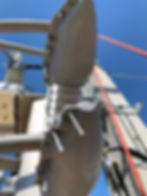ANIMALS TRIGGER OUTAGES
The reliability, security, and quality of power systems are significantly affected by distribution faults. These faults can be triggered for many different reasons, an animal induced fault is one them. A potentially harmless, inquisitive squirrel induced an outage causing 60,000 gallons of untreated sewage flowing into the San Sebastian River in Florida. In Seattle, 40,000 residents lost power due to an invasion of a substation by an innocuous raccoon. Among the different categories of power distribution faults, animal-caused faults and outages are presumably the ones that can be prevented most easily and effectively if appropriate control actions are taken.

THE PERPETRATORS
The animals responsible for approximately 95% of all animal-caused outages, as reported by the utilities, are divided into the following categories:
1. Small digging and climbing animals – Tree squirrels, ground squirrels, gophers, moles, rats, and mice
2. Common birds - Starlings, sparrows, doves, blackbirds, woodpeckers, blue herons, and migratory waterfowl
3. Snakes
4. Medium climbing animals - Raccoons, cats, and opossums
5. Raptors (birds of prey)-Eagles, hawks, owls, ospreys, and vultures
6. Large animals - Cattle, horses, bison, and bears
7. Other animals - Bats, insects, tree frogs, and beavers
The first section under each category of animal is a discussion of the type of behavior that tends to bring the animal into conflict with electric utilities.

WHY ANIMALS TEND TO INTERFERE WITH POWER SYSTEM?
There are various reasons why animals enter substations. For example, cats enter substations for warmth, woodpeckers create holes for shelter and to store food, and birds build nests on equipment and structures. Raccoons and snakes try to reach bird nests for young birds and eggs. Squirrels, especially during weaning cycles, migrate through unfamiliar territory. Predators, such as foxes, enter a substation looking for rodents and other nocturnal animals that make homes in vaults, equipment, and structures.
THE MOST VULNERABLE ELECTRICAL EQUIPMENT
The electrical equipment most susceptible to animal-related damage includes power transformers, capacitors, breakers, reclosers, surge arresters, voltage and current transformers, regulators, switchgear, potheads, switches, bushings, insulators, and bus conductors.
In Transmission towers, the most troublesome location is the conductor between suspension insulators. Contamination from bird seating or nesting in towers causes flashover as it travels close to conductors decreasing the air gap.
AFFECTS DUE TO ANIMAL-INDUCED OUTAGES
Animal-related outages run the gamut from momentary disturbances to long-term outages. Major portions of substations can be tripped offline, including transmission circuits. Outages, sustained or momentary, reduce the long-term confidence of all customers and could be a critical factor for uninterrupted quality power distribution. These problems can become serious if these are repetitive in a particular substation or class of substations. Transmission outages are costly and insulators contaminated by bird droppings are expensive to clean.
HOW TO PREVENT ANIMAL-INDUCED ELECTRICAL INTERRUPTIONS?
The most crucial aspect regarding distribution faults is the implementation of more preventive measures instead of reactive measures. In other words, we would like to prevent faults from happening rather than restore the system after faults occur.
Considering the enormous cost and complexities due to animal outages, it might be surprising to some that almost all the problems we encounter as a direct or indirect result of animal interferences are preventable. Wildlife guards, insulating covers on transformer bushings, are one of the oldest and most widely used deterrents. Unfortunately, most utilities are now finding that the guards installed in the early years have severely deteriorated from weathering, ultraviolet light, and chewing by squirrels, because most of these coverings are made of plastic.
Midsun IKM, based in Austria, specializes in distributing over 100 wildlife outage protection products. It offers ready-made products that assures flexibility, hydrophobicity, 100% made from 65 durometer silicone, superiority in UV resistance, chemical resistance, and sustains expected life beyond 20 years.
Along with our better understanding of the challenges comes additional pressure from environmental bodies who have the best interests of the wildlife at risk of being electrocuted uppermost in their arguments. Historically the area of concern was most often that of the electrical power provider, whose reliability was the critical factor, but today both points of view require consideration.
